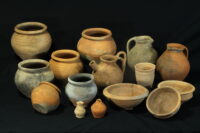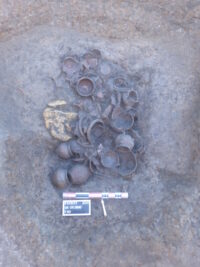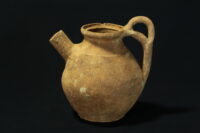 Archaeologists have unearthed hundreds of kilos of Merovingian-era pottery in the village of Sevrey in eastern France. Many of the vessels are in excellent condition and there are some types that have never been recorded before.
Archaeologists have unearthed hundreds of kilos of Merovingian-era pottery in the village of Sevrey in eastern France. Many of the vessels are in excellent condition and there are some types that have never been recorded before.
Mentioned in medieval texts, the Sevrey workshop was the only one in the region to produce the orange/brown pottery known as bistre ceramic. Pottery production in Sevrey was continuous from the 5th century through the 19th. Examples of its have been found from the Swiss Jura to Vienna and south to the shores of the Mediterranean.
The classic forms of a bistre service largely dominate the repertoire of productions, namely pots, jugs, carinated bowls and mortars. In addition to these classic standards, there are also several recurring shapes such as cups, lamps, bottles or lids. The presence of some exceptional pieces is to be noted such as a jug with a double handle or miniature vases, evoking specific tests or orders.
 This fall’s excavation in advance of a real estate development allowed archaeologists to explore the full process of pottery production in the Merovingian period. They discovered workpits along the axis of a road that were later reused to dump trash. They also discovered a sump, a rectangular pit used to collect water, evidence of how water was managed in the manufacture of ceramics. There is also a large amount of iron slag from an associated forge and butchered animal remains.
This fall’s excavation in advance of a real estate development allowed archaeologists to explore the full process of pottery production in the Merovingian period. They discovered workpits along the axis of a road that were later reused to dump trash. They also discovered a sump, a rectangular pit used to collect water, evidence of how water was managed in the manufacture of ceramics. There is also a large amount of iron slag from an associated forge and butchered animal remains.
 Various pits and post holes were found packed with discarded kiln failures from the late Middle Ages, a little-known period in Sevrey archaeology. The discovery of abundant terracotta construction materials — roof tiles, ridge tiles, bricks — suggest the workshops may have whole production lines in the 6th and 7th centuries previously unknown to archaeologists.
Various pits and post holes were found packed with discarded kiln failures from the late Middle Ages, a little-known period in Sevrey archaeology. The discovery of abundant terracotta construction materials — roof tiles, ridge tiles, bricks — suggest the workshops may have whole production lines in the 6th and 7th centuries previously unknown to archaeologists.
Thus, despite a limited area, the high density of remains correlated with the phenomena of stratification of the land and the abundance of material provide a large panel of data, likely to be integrated into the overall context of the medieval village of Sevrey and its potters’ workshops.
In the first picture I particularly like all these cool Merowingian colors:
Reddish, brownish, yellowish, greenish and whitish and blueish :love: